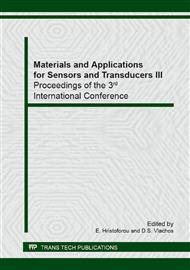[1]
E. Hristoforou, "Magnetostrictive Delay Lines: Engineering Theory and Sensing Applications", Meas. Sci. & Technol., 14, p. R15-R47, (2003)
DOI: 10.1088/0957-0233/14/2/201
Google Scholar
[2]
I. Giouroudi, A. Ktena and E. Hristoforou, Microstructural characterization of cylindrical Fe1-xNix thin films, J. Opt. Adv. Mat., 6, pp.45-50, (2004)
Google Scholar
[3]
K. Kosmas, E. Hristoforou, The effect of magnetic anomaly detection technique in eddy current non-destructive testing, International Journal of Applied Electromagnetics and Mechanics, 25, pp.319-324, (2007)
DOI: 10.3233/jae-2007-826
Google Scholar
[4]
K. Kosmas, C. Sargentis, D. Tsamakis, E. Hristoforou, Non-destructive evaluation of magnetic metallic materials using Hall sensors, Journal of Materials Processing technology, 161, pp.359-362, (2005)
DOI: 10.1016/j.jmatprotec.2004.07.051
Google Scholar
[5]
E. Hristoforou, A. Ktena, Magnetostriction and magnetostrictive materials for sensing applications, J. Magn. Magn. Mater., 316, pp.372-378, (2007)
DOI: 10.1016/j.jmmm.2007.03.025
Google Scholar
[6]
E. Hristoforou, Amorphous Magnetostrictive Wires Used in Delay Lines for Sensing Applications, J. Magn. Magn. Mater., 249, pp.387-392, (2002)
DOI: 10.1016/s0304-8853(02)00563-2
Google Scholar
[7]
E. Hristoforou, K. Kosmas, Magnetostrictive delay lines for non-destructive testing, International Journal of Applied Electromagnetics and Mechanics, 25, pp.287-296, (2007)
DOI: 10.3233/jae-2007-794
Google Scholar
[8]
E. Hristoforou, D. Niarchos, H. Chiriac, M. Neagu, Non Destructive Evaluation Distribution Sensors Based on Magnetostrictive Delay Lines, Sensors & Actuators A, 92, pp.132-136, 2001.
DOI: 10.1016/s0924-4247(01)00551-9
Google Scholar
[9]
E. Hristoforou and R.E. Reilly, Tensile Stress Distribution Sensors Based on Amorphous Alloys, J. Magn. Magn. Mat., 119, pp.247-253, (1993)
DOI: 10.1016/0304-8853(93)90408-t
Google Scholar
[10]
E. Hristoforou, K. Kosmas, M. Kollar, Surface magnetic non destructive evaluation using permeability sensor based on the MDL technique, Journal of Electrical Engineering, 59, pp.90-93, (2008)
Google Scholar
[11]
E. Ioakeimidis, V. Kytopoulos, E. Hristoforou, Investigation of magnetic, mechanical and microfailure behavior of ARMCO - type low carbon steel corroded in 3.5% NaCl - aqueous solution, Materials Science and Engineering A, MSEA-D-13-00774, accepted (2013)
DOI: 10.1016/j.msea.2013.06.072
Google Scholar
[12]
A. Ktena, E. Hristoforou, Stress Dependent Magnetization and Vector Preisach Modeling in Low Carbon Steels, IEEE Transactions on Magnetics, 48, pp.1433-1436, (2012)
DOI: 10.1109/tmag.2011.2172786
Google Scholar
[13]
Alex Hubert and Rudolf Schafer, "Magnetic Domains: The analysis of Magnetic microstructures", Springer Verlag, Berlin, Heidelberg, New York, corrected printing 2000.
Google Scholar
[14]
R. M. Bozorth, "Ferromagnetism", Van Nostrant, Princeton, (1951)
Google Scholar
[15]
J. M. Makar and D. L. Atherton, IEEE, Trans. Magn.., vol. 30, p.1380, (1994)
Google Scholar


